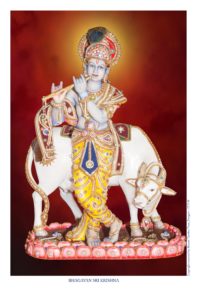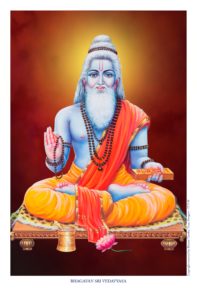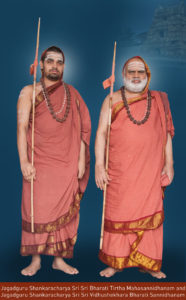Guru Poornima Parayana
The full moon day of the Aashaadha month marking Guru Poornima or Vyasa Poornima is of great significance for followers of Sanatana Dharma. The day is earmarked for offering our prayers and respects to all the Mahatmas incarnate in the lineage of Gurus who lead us along the path of welfare. In accordance to this tradition, it is the duty of every Astika to offer prayers on Guru Poornima to all Acharyas of the Parampara starting from Lord Sadashiva to our Jagadguru.
With the blessings and guidance of Jagadguru Shankaracharya Sri Sri Bharati Tirtha Mahasannidhanam and Jagadguru Shankaracharya Sri Sri Vidhushekhara Bharati Sannidhanam, a program has been conceived to conduct Parayana on the occasion of this very auspicious Guru Poornima to obtain the compassionate grace of the Acharyas.
This small compendium published by the Peetham, contains shlokas for Parayana, and the Ashtottara Shatanamavalis. It is titled Guru-Saparyaa, meaning worship of the Guru.
Every follower of Sanatana Dharma may wholeheartedly perform this Parayana on the sacred period of Chaturmasya and obtain the blessings of the Guru.
The significance of Guru Poornima
In our tradition, we revere even a person who imparts knowledge of even a single syllable. Our tradition places the Guru imparting Brahma-vidya as the highest object of our devotion. The Upanishads state that all welfare ensues to the one who has immense devotion towards the Guru just as he has towards God.
यस्य देवे पराभक्तिर्यथा देवे तथा गुरौ ।तस्यैते कथिता ह्यर्थाः प्रकाशन्ते महात्मनः॥
The Upanishads direct the seeker of the knowledge of the Self to undertake refuge in the Guru. Srimad Bhagavad Gita also instructs the seeker to serve the Guru, upon which the Guru imparts Self-knowledge.
तद्विद्धि प्रणिपातेन परिप्रश्नेन सेवया ।उपदेक्ष्यन्ति ते ज्ञानं ज्ञानिनस्तत्त्वदर्शिनः॥
On Guru Poornima, worship is offered to the entire Guru Parampara beginning from Lord Shiva. Special worship is offered to Bhagavan Sri Krishna, Bhagavan Veda Vyasa, and Jagadguru Sri Adi Shankara Bhagavatpada.
Bhagavan Sri Krishna
The Lord Almighty incarnate as Sri Krishna in the Dwapara Yuga protected Dharma by annihilating all evil and protecting the noble. Bhagavan Sri Krishna imparted the knowledge of the essence of the Upanishads in the form of Bhagavad Gita, with Arjuna as the instrument. This has been depicted beautifully as if the Lord is a cowherd milking the nectarine Bhagavad Gita from cows that are the Upanishads, first for the sake of the calf that is Arjuna and subsequently for every noble person.
सर्वोपनिषदो गावो दोग्धा गोपालनन्दनः ।पार्थो वत्सः सुधीर्भोक्ता दुग्धं गीतामृतं महत्॥
Hence we revere Sri Krishna as Jagadguru − “कृष्णं वन्दे जगद्गुरुम्”.
Salutations to Bhagavan Sri Krishna, the Supreme Preceptor and Witness, who is the personification of Sat (pure existence), Chit (consciousness) and Ananda (unalloyed bliss), who brings about the state of blessedness and who is to be known through Vedanta –
सच्चिदानन्दरूपाय कृष्णायाक्लिष्टकारिणे ।नमो वेदान्तवेद्याय गुरवे बुद्धिसाक्षिणे॥
Bhagavan Veda Vyasa
Bhagavan Veda Vyasa is an incarnation of Lord Mahavishnu. Bhagavan Sri Krishna declares in the Vibhuti Yoga (Chapter 10) of the Bhagavad Gita, “मुनीनामप्यहं व्यासः” − “I am Veda Vyasa among sages.”
Bhagavan Veda Vyasa, addressed so because he classified the Vedas into four, is also known by the epithets – Badarayana, as he resides in Badarikashram – Paaraasharya, as he is the son of Paraashara Maharshi, and – Krishna-dwaipaayana because he was born on the banks of Yamuna river.
Bhagavan Veda Vyasa classified the Vedas into Rig, Yajus, Sama and Atharva and imparted them to Paila, Vaishampayana, Jaimini and Sumantu respectively. He penned the Brahmasutras to succinctly convey the import of the Upanishads. Bhagavan Veda Vyasa composed the 18 Mahapuranas, Upapuranas and the Mahabharata to describe the way of life adjoined in the Vedas, and to make easily accessible the principal philosophical tenets of Sanatana Dharma for all. In addition, these works contain many hymns including those widely chanted such as Sri Vishnu Sahasranama, Sri Lalita Sahasranama, Sri Shiva Sahasranama, Sri Durga Saptashati among others.
Every follower of Sanatana Dharma is indebted to Bhagavan Veda Vyasa, the Jagadguru.
Sri Shankara Bhagavatpadacharya
Twelve centuries ago, when Sanatana Dharma was at an ebb and a number of non-Vedic schools and incorrect interpretations were rife in society, Lord Parameshwara incarnated as Sri Shankara to the blessed couple, Shivaguru and Aryamba, in the hamlet of Kalady in Kerala.
Sri Adi Shankara Bhagavatpada completed the study of the four
Vedas by his eighth year, embraced Sannyasa by seeking refuge in Sri Govinda Bhagavatpada, formally received Atma Vidya from His Guru, wrote the Prasthana-traya Bhashya and independent Vedantic treatises, composed hymns extolling the Divine in various names and forms, travelled throughout the country dispelling wrong notions and non-Vedic schools and imparted the correct Vedic import to everyone. Sri Adi Shankaracharya propagated the Upanishadic philosophy of Advaita and lucidly explained the path to Moksha (liberation).
To ensure the continued propagation of Sanatana Dharma, Sri Adi Shankara Bhagavatpada established four Peethams in the four directions of the country – the Sharada Peetham at Sringeri (south), the Govardhana Peetham at Puri (east), the Kalika Peetham at Dwaraka (west), and the Jyothish Peetham at Badari (North). Having accomplished the purpose of the incarnation, Sri Bhagavatpada reached Kedarnath in the Himalayas, blessed all disciples and disappeared.
अवतीर्णश्च कालट्यां केदारेऽन्तर्हितश्चयः । चतुष्पीठप्रतिष्ठाता जयताच्छङ्करो गुरुः ॥
It is indeed fitting that Sri Adi Shankaracharya who accomplished so much in a short life of 32 years, is revered as a Jagadguru for having laid down the path for ennobling the lives of every human.
The Jagadgurus of Dakshinamnaya Sri Sharada Peetham
The Dakshinamnaya Sri Sharada Peetham, the first and foremost amongst the Peethams established by Sri Adi Shankara Bhagavatpada at Sringeri, is adorned by an illustrious Guru Parampara beginning from Sri Adi Shankaracharya and His direct disciple, Sri Sureshwaracharya. All the Jagadgurus of the Peetham have been carrying aloft the torch of Dharma and guiding Astikas. They have followed the injunctions for a Peethadhipati as set forth by Sri Adi Shankaracharya. They have shown the path to welfare for everyone leading a life of complete adherence to Sannyasa Dharma. The Sringeri Jagadgurus including Sri Sureshwaracharya, Sri Vidyatirtha, Sri Bharati Tirtha, Sri Vidyaranya, (and in recent times) Sri Sacchidananda Shivabhinava Nrisimha Bharati, Sri Chandrashekhara Bharati and Sri Abhinava Vidyatirtha are deeply revered by one and all. The current Acharya, Jagadguru Shankaracharya Sri Sri Bharati Tirtha Mahasannidhanam & the Uttaradhikari Shishya, Jagadguru Shankaracharya Sri Sri Vidhushekhara Bharati Sannidhanam occupy a worshipful position in the minds and hearts of all.
It is hence our duty to remember and offer our prayers to this great lineage of Gurus on the auspicious Guru Poornima.
Parayana Text
To enable the devotees from different states and region to involve themselves and chant this Parayanam the Stotras and Ashtottara Shata Namavalis are given in Kannada, Tamil, Telugu and Devanagari scripts. This is available in Mobile Tablet and Computer Viewable version and Printable version in 1/8 demmy size.
Gurusaparya Book in Kannada for Mobile, Tablet and Computer viewing
Gurusaparya Book in Devanagari Mobile tablet and Computer viewing
Gurusaparya Book in Tamil for Mobile, Tablet and Computer viewing
Gurusaparya Book in Telugu for Mobile Tablet and Computer viewing
Gurusaparya Book in Telugu script Printable version
Gurusaparya Book in Tamil script Printable version
Gurusaparya Devanagari printable version




